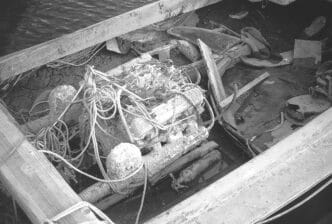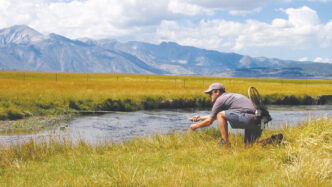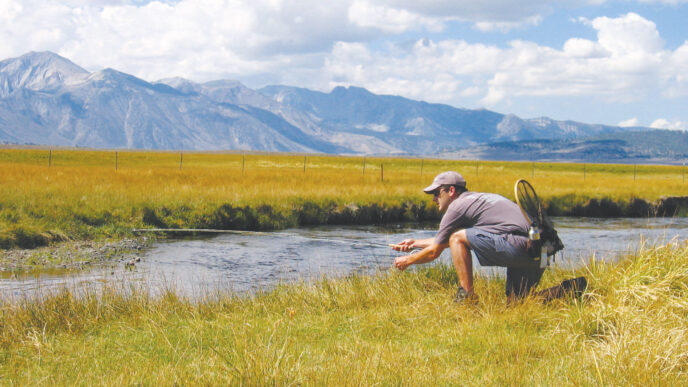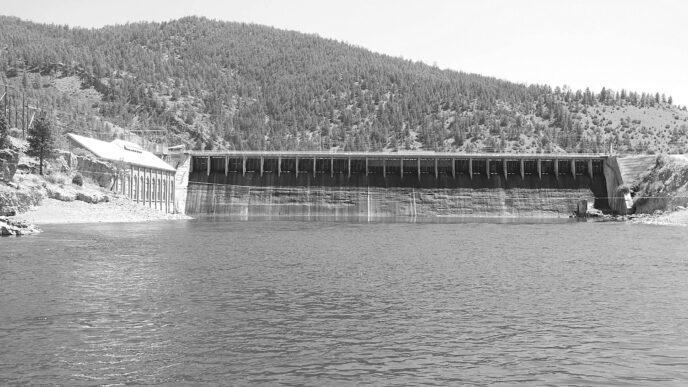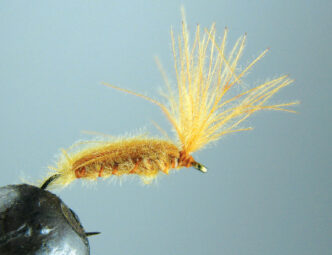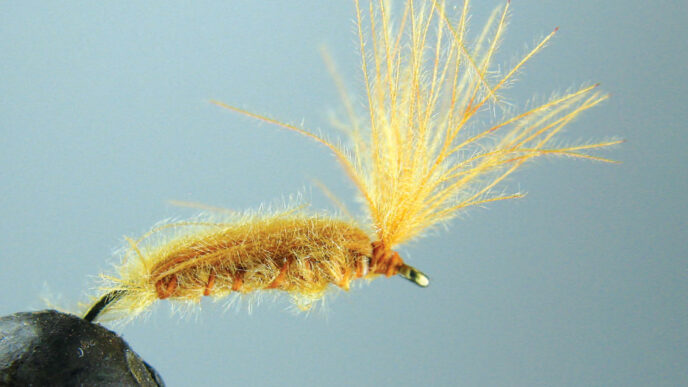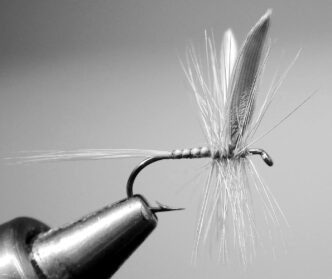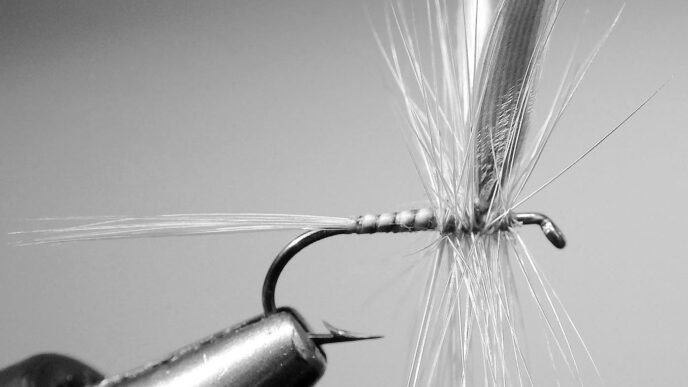One of the interesting things about fly-rod angling for bass and the other species you’ll mostly find in lakes is that much of your fishing takes place not in flowing water or while you are wading or on foot on dry land, but from a floating platform of some kind.
I originally wanted to talk only about basic boat safety, but realized that today, the fly angler has at his or her disposal a fair number of different kinds of watercraft. Not many of us are zooming around in bass boats. Still, the basic rule is this: if it floats, it will probably sink if you do something stupid. Over the forty-some years I’ve been chasing bass and stripers (trout, too) on still waters, I’ve seen a fair number of boating accidents.
It will probably surprise some readers, but a boat sinking is less dangerous than you might expect. Most recreational boat sinkings, unless accompanied by some catastrophic event, are relatively slow affairs. Once, while fishing near Martinez Lake on the lower Colorado River, my wife and I helped rescue three guys who had launched a fast fiberglass bass boat and had forgotten to install the drain plug. They even had forgotten to bring it with them.
When they discovered the boat was taking on water, they attempted to fill the drain hole with a rag, but it was too late. Most bass boats are built with extra floatation, so while they got their legs wet, the boat didn’t entirely sink. We managed to tow the nearly submerged boat back to the launch ramp.
Another time, we came upon an aluminum bass boat that had struck some floating object that had popped open the bottom. The gash was nearly a foot long, and it did not take long for the boat to sink. It wound up with the bow sticking out of the water, with the motor submerged as far as the depth would allow. The two anglers had floatation vests, plus seat cushions that floated, so they were wet, but otherwise OK.
Float tubes and pontoon boats are very safe and hard to sink. Most modern tubes have multiple floatation chambers, and it’s doubtful that you can spring a leak in all of them at the same time. Even the old round tubes that used a truck tire inner tube are very hard to sink. My wife once noticed her tube was getting soft. She hunted around and found a pinhole leak in the front, probably from a sharp tule stem. She held a finger over the spot and paddled to the shore. I patched the tube, and we went back to fishing.
Fire, on the other hand, can be a sudden and serious problem. Fire is a safety issue that most folks don’t associate with fly fishing or with boats, but it can be a real threat. I’ve never been in a boat fire, but I’ve watched helplessly as more than one boat burned to the waterline and sank. This is most often the fate of a fiberglass boat involved in a fuel fire. A fire extinguisher is a very practical thing to have on any gasoline-powered boat. It also helps if you keep the fuel tank or tanks and fuel lines well maintained. If you have a fire and don’t have an extinguisher handy, about the only thing you can do is jump overboard and swim for safety. There are different kinds of fire extinguishers around. Make sure you get one intended for fuel fires.
Another item that you’ll want on lakes, whether you fish from a float tube, a kayak, an inflatable pontoon boat, or a big bass boat, is a flashlight. It’s amazing how many things that can go wrong wait until it’s dark. Of course, it’s also handy to have a light when changing flies or tying on a new tippet past dusk. If you don’t have a headlamp, try to get a flashlight small enough to hold in your teeth.
Some jobs require both hands.
I personally like modern LED flashlights. They are very bright, batteries tend to last a long time, and they are often quite small. Plan on spending a little money here. One of those two-dollar models from China will work most of the time, but a high-quality flashlight of the “tactical” type that you find in gun magazine ads is the same thing, only made as tough as nails. I had one of the cheap flashlights expire during a pitch-black night while striper fishing, and I discovered that my backup light was just about useless, too. I fell twice trying to get back to my car and kept worrying about every little noise I heard being something with big teeth. Since then, I have quit doing much dark-of-night fishing, and I carry better equipment whenever I fish, day or night.
The bare minimum in safety equipment for smart boating is a personal floatation device for each occupant. You can buy a good floatation vest for a lot less than you’d spend on a new fly line. While I have used all kinds of safety floatation vests, I prefer the CO2 inflatable kind for its comfort and wearability in hot weather, and lately, I have been wearing a kayaker’s paddling vest, which is also cool in warm weather.
I was going to assume that you all carry a first-aid kit while fishing, but when I asked my fishing buddies what their first-aid kit contains, I got enough blank looks that I decided to discuss that, as well.
A simple first-aid package will at minimum have a few bandages (Band-Aids or the equivalent) and perhaps a couple of single-use alcohol pads for cleaning wounds or cuts. These can go in a Ziploc sandwich bag. I typically add a couple of large-area Band-Aids to cover ragged cuts or bruises that may bleed. I’m diabetic and take blood thinners, so any bruise or minor cut I get while fishing tends to bleed like crazy. I come prepared.
Since I wear glasses, one of those little eyeglass screwdrivers and a selection of screws that fit my glasses (and my sunglasses) frames also goes into the kit. I add a coil of a few feet of hard steel wire in a very small diameter. The wire can be wound around a rod to hold a guide in place or used as emergency “thread.” I’ve used this wire to fix a broken belt buckle and to refasten a shirt button that had broken off.
I carry a small, hard-shell plastic box first-aid kit. It fits in a pants pocket or one of the pockets of my fishing and hunting vests. It also contains more bandages and my medications. Meds include any prescription medications you need to take if you are stuck someplace longer than a single day (or overnight) and general pain meds such as aspirin or acetaminophen. When I am fishing in uncertain weather, I like to add various fire-starting tools — anything from a pack of matches to magnesium fire-starting devices that can get a fire going in cold or rainy weather. I like to bring both when hunting, and lately have been carrying a waterproof match safe. (We used to use 35-millimeter film cans for match safes, but those are getting as hard to come by as the film itself.) These days, I put wood matches in a small plastic tube that has a sealing lid. Works fine. I often carry a ordinary butane lighter, so I don’t have to play Boy Scout in the rain to get a fire started.
On a boat, I like to have a larger first aid kit. You’ve got room, so why not? I have a backup kit that normally resides in my truck and that goes into the boat at launch time. It has everything you might need short of doing field surgery, including a book of how-to instructions for treating medical problems ranging from rattlesnake bites to broken legs. If you have an instruction book in your kit, make sure it is up to date, as procedures can change over time.
I carry my cell phone when lake angling, since on anything other than giant lakes such as Powell or Mead on the Colorado River, you are often within range of a cell tower. A cell phone doesn’t take the place of a radio in your boat, but it is often handy. Turn your phone off while you are on the water. This does two things: First it keeps the phone from discharging as you pass in and our of reception areas. Second, it keeps you from being bothered when fishing. As for the radio, a citizens’ band unit is often helpful, but a marine radio is usually better. Just be sure to find out what emergency frequency is monitored by the park rangers or other rescue agency.
Another modern tool I now carry when fishing is a GPS device. An inexpensive hand-held unit is perfect. It allows you to mark things such as your launch point and other features, plus, you can mark hot “honey holes” that you will want to return to later. If your cell phone has a GPS feature, make sure it is enabled, but bring the separate GPS along, as well. Someplace in your tackle you should also have spare batteries for all your electronic devices.
Obviously, you can’t outfit yourself to take care of every kind of injury that might happen, either to you or your fishing partner. If you carried all that stuff, there’d be no room for fishing tackle. The most common injury you’ll likely suffer is a stumble and fall. This can result in anything from a bruise to a broken bone, with a cut that bleeds and needs attention being the mostly likely outcome of doing something fumble-footed. Falls are more common while on land, but I once fell down in a boat and cut my hands on the sharp edge of a rod rack.
I fished with a guy from Lake Havasu City once who had laid his left leg open on a piece of bent tin on the edge of a dock. It eventually required several stitches to close at an emergency room, but we managed to fish all day first with a decent bandage and some disinfectant.
Another common injury a fly angler will encounter is caused by the sharp hook on the very fly that he or she is casting. (Although I once helped treat a guy who fell while holding an open book of streamer flies and who hooked himself not once, but three times in his right hand.) Extracting a hook from an ear or hand isn’t difficult. With small flies and barbless hooks, it’s a simple job. It’s only slightly less simple if the hook is barbed.
With large streamers and bass bugs, however, removing a hook from flesh is something else again. The clever trick you’ve probably seen illustrated, snapping the hook out on a small fly with a loop of leader material, may not work, and it can be painful.
Sometimes, depending on where the angler is hooked, it is better with big hooks (size 2 to 2/0 or so) to push the point on through and cut it off with wire cutters or dykes. You have to have included these in your kit to start with, of course. I once talked to a guy who, while casting a big streamer fly, performed a roll-cast pickup and slammed the hook into his nose. He had to visit a clinic to get the thing removed, and he said all efforts short of doing that had hurt so badly that he simply had cut the leader and had fished all day with the streamer dangling from his nose. I once was hooked in the top of my head on a salmon stream in Alaska. There were three of us fishing a sandbar, and the guy to my left nailed me in the noggin with a big chrome jig. We had some dykes with us, so the guy, obviously a little shaken by the whole thing, took off running to get them from the third angler. He forgot to put his rod down before breaking into a run, and I had to grab his line and nearly jerk him over backwards to avoid being scalped. Not all mishaps that occur while fishing are serious enough to require first aid, and most trips don’t end with a ride back to the docks in a rescue boat. Still, it’s a lot better to be at least minimally prepared. You do not need to spend very much to equip yourself with the basics.



